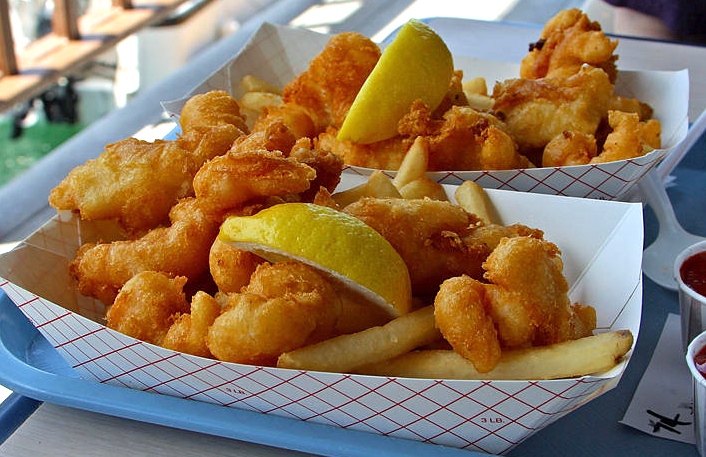Published in the Ocean Watch column, Honolulu Star-Advertiser © Susan Scott
July 27, 2007
RECENTLY, AS my friend and I ate fish and chips at an outdoor cafe, we wondered what kind of fish we were eating. I guessed shark, he guessed cod.
Later when I looked it up, I discovered either of us might be right. Or wrong. The fish used in fish and chips varies from country to country, region to region and restaurant to restaurant.
In Australia, where I was when this subject came up, people prefer reef fish, such as barramundi, for their breaded (they call it crumbed), deep-fried fish. But Australians also like flake, the term used there for the meat of black-tipped reef and other small sharks.
In Britain, where fish and chips is a staple, people prefer haddock and cod, but plaice (two species of flounder), skate and rock salmon are also popular. Rock salmon there means small sharks including dogfish.
In New Zealand you’ll often get snapper in a fish-and-chips shop, but lemon shark is popular there, too. Because of this, a local name there for fish and chips is “shark and taties.” Only the Kiwis, it seems, aren’t afraid to call a shark a shark.
Canadians and Americans use both freshwater and saltwater species for the North American version of fish and chips. In the Great Lakes region (where I grew up), restaurants and bars offer fish fries on Fridays. Originally a service for Catholics who didn’t eat meat on Fridays, fish fries are still a popular Friday tradition.
But not in Hawaii. You won’t find fish fries or fish and chips on many Hawaii menus. Here breaded, deep-fried fish usually comes in the form of tempura. And you don’t get fries with that.
The British didn’t invent fish and chips, but they did put the two together. Jewish immigrants from Spain and Portugal in the 17th and 18th centuries brought the battered, fried fish idea to Britain. (The Portuguese also brought it to Japan.)
Initially British vendors sold fried fish alone. In “Oliver Twist,” published in 1838, Charles Dickens mentions a fried-fish warehouse. People fried the fish in shallow pans and served it cold.
Later, some sellers began including a baked potato with their fish. But because boiling oil was right there, it was easier to fry the potatoes the way the French did, in strips. When “pomme frites” replaced the baked potatoes, a tradition was born.
Fish and chips wrapped in newspaper was originally a cheap meal for the poor, and the trade was considered unpleasant. The shops stank and some people thought them unsanitary. “It is a source of considerable nuisance in some neighborhoods,” wrote a London health inspector in 1876, “the offensive smell of the oil (lard) boiling and the fish frying spreading often through the whole length of the street where the shop is situated.”
That negative image changed during World War II when fish and chips became one of the few foods in Britain not rationed.
Today fish and chips is a classless meal, and in countries where it’s popular, people eat it anywhere and everywhere. Instead of using newspaper though, vendors now serve their product in polystyrene containers, cardboard boxes or butcher block paper.
My friend and I never found out what kind of fish we ate, but we didn’t care. It was deep fried. Of course, it was good.
